What's New
Displaying results 1661 - 1670 of 4052
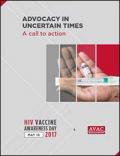
Resource | Publications,
These are hectic times. There is more information coming at all of us than at any time in human history. And in many parts of the world, that information raises cause for alarm or concern. There are multiple top-priority issues. Many things need attention right now.
How, then, do we advocate for an HIV vaccine, which will not be available until into the 2020s, at the earliest? We advance a near-, mid- and long-term agenda with passion and precision. Moreover, advocates—the “we” invoked throughout this piece—can do this work with more confidence than ever. The history of the response to many other epidemics tells us that an effective preventive vaccine is essential. An epidemic can be controlled with treatment and other prevention—just as HIV is coming under control today. But a sustained end has almost always depended on a vaccine. This year on HIV Vaccine Awareness Day, our core message is simple: No end without a vaccine; no vaccine without funding.
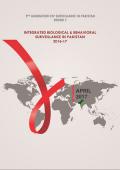
Resource | Publications,
This report provides biological and behavioural information related to HIV infection among four key populations:
- People who inject drugs (PWID)
- Men who have sex with men (MSM)
- Transgender populations
- and Female Sex Workers (FSWs)

Resource | Publications,
The purpose of the 2016 NDHS was to generate reliable information on fertility; family planning; adult and child mortality; maternal and child health; nutrition; women’s empowerment and domestic violence; knowledge of HIV and AIDS; and other health issues. Data collection for the survey was carried out from June 19, 2016, to January 31, 2017. This report, which presents key findings from the 2016 NDHS, is intended to provide policy makers and program managers with a first glimpse of the survey results. A more comprehensive, detailed report is scheduled for late 2017.
This key indicators report presents a first look at selected findings of the 2016 NDHS. A comprehensive analysis of the data will be presented in a final report in September 2017.

Resource | Tools,
Programmatic mapping (PM) is a collaboration among key population (KP) communities (sex workers [SWs], people who inject drugs [PWID], men who have sex with men [MSM], and transgender people); service delivery providers; and researchers to systematically identify and map the locations where people most at risk of acquiring and transmitting HIV can be reached. It is a tool to focus HIV prevention programing and resources where they will have the greatest impact on the HIV epidemic.
The Programmatic Mapping Readiness Assessment Tool provides an adaptable step-by-step guide for conducting an mapping readiness assessment (MRA). The MRA focuses on the safety and well-being of KPs as a group and individuals within the group; helps identify the potential risks and benefits of conducting PM before initiating the mapping process; and guides discussions among program staff, steering committee members, and community leaders in creating an action plan to address risk.
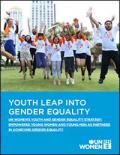
Resource | Publications,
There are 1.8 billion young people aged 10-24 years old in the world—the largest youth population ever. The new 2030 Agenda for Sustainable Development is largely about youth and for the youth. Therefore, we cannot dismiss today’s young men and young women as solely the beneficiaries of development or even as the leaders of tomorrow – for they are already leading today! The force and inspirations of our youngest leaders represent one of the critical drivers for accelerating progress on sustainable development and gender equality.
At UN Women, we recognize the need to include and engage young men and young women with greater seriousness and urgency. We are at a defining moment at which the women’s movement and the youth movement must come together with stronger partnerships and greater focus to ensure that the new agenda for sustainable development delivers for all women and girls, especially those facing multiple and intersecting forms of discrimination and marginalization. This is a critical moment for action.
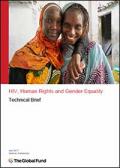
Resource | Publications,
The purpose of this Technical Brief is to assist Global Fund applicants in their efforts to include and expand programs to remove human rights and gender-related barriers to HIV prevention, diagnosis and treatment services. This Brief discusses the barriers these programs help to remove, the various forms the programs take, the need to cost and allocate budget for them, and how to implement them in effective ways and at appropriate scale. It also aims to help stakeholders ensure that, as they are rolled out, HIV health services and programs promote and protect human rights and gender equality.
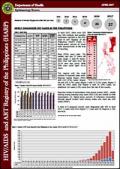
Resource | Fact Sheets,
In April 2017, there were 629 new HIV antibody sero-positive individuals reported to the HIV/AIDS & ART Registry of the Philippines (HARP). Eighty-seven percent of those were asymptomatic at the time of reporting.
Most (95%) were male. The median age was 27 years old (age range: 2 year-79 years). More than half were from the 25-34 year age group while 30% were youth aged 15-24 years.
The regions with the most number of reported cases were: National Capital Region (NCR) with 234 (37%) cases, Region 4A with 109 (17%) cases, Region 7 with 71 (11%) cases, Region 3 with 56 (9%) cases and Region 6 with 25 (4%) cases. An additional 134 cases (21%) came from the rest of the country.
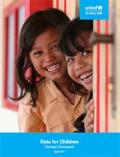
Resource | Publications,
This framework focuses on data for and about children: the well-being and perspectives of children and their families, the environments in which they live, and the ways that services and systems reach – or fail to reach – them. For more than four decades, UNICEF has supported governments in generating, analysing and using many different forms of data related to these issues. All of these forms – from longstanding and statistically robust household survey programmes to government administrative data and new forms of community feedback mechanisms – are within the scope of the framework.
The idea behind the strategic framework is not to build a perfect world that can address any unforeseen data need; rather, it lays out a general approach to data for children work and a plan for addressing our existing needs, while giving us the flexibility to adapt as our needs evolve.
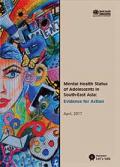
Resource | Publications,
Mental health problems are estimated to affect 10–20% of children and adolescents worldwide, accounting for 15–30% of Disability-Adjusted Life Years (DALYs) lost during the first three decades of life (Kieling, Baker-Henningham et al. 2011). Suicide or self-harm, itself, accounts for an estimated 6% of all deaths among 15–29 year olds population and is the second leading cause of death in this age group after road-traffic injuries (WHO, 2014).
This publication provides evidence from nationally representative school health surveys, implemented as part of the Global School-based Student Health Survey Initiative, on prevalence of self-reported suicidal behaviours and other warning signs of mental health problems. It thereby aims to raise awareness of mental health problems among adolescents. It also aims to show associations of suicidal behaviours and mental health symptoms with potential protective behaviours (e.g. parental engagement) and risk factors (e.g. bullying) that may help inform public health interventions to address this important issue. Finally, it assesses the co-morbidity of substance use and mental health problems.
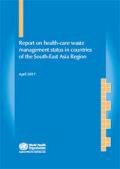
Resource | Publications,
This report – Report on health-care waste management (HCWM) status in Countries of the South-East Asia Region (SEA Region) – presents an assessment of health-care waste management policies and practices in 10 Member States of the WHO South-East Asia Region. Primary data from health-care facilities, secondary data obtained through the ministries of health, and status reports presented by focal points of the ministries of health from 10 Member States that attended a regional workshop on health-care waste management in 2016 were used in preparing this report.
Although compliance on health-care waste management remains a big challenge in many Member States, there are some good practices which have been documented in this report. WHO will continue to work with the ministries of health to raise awareness, develop capacity, and institutionalize management of health-care wastes to protect patients, health workers, hospital staff and the community.





